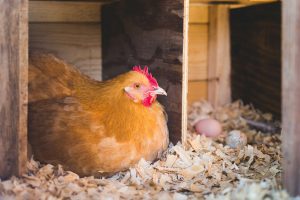The majority of people that own chickens get chickens so that they can have fresh, wholesome eggs. That’s a wonderful reason to have chickens. However, for many new chicken owners, the whole idea of your chicken laying eggs can bring up a bunch of new questions. One of the most common questions that I get from new chicken owners has to do with the nesting box and whether or not you need anything in it. Let’s talk about the purpose of the nesting box and whether you need anything in it or not.
The purpose of the nesting box
Hens are very social creatures, until it comes times to lay an egg. Chickens are prey animals in nature. Because they are prey animals, they have adapted to conceal themselves when they are most vulnerable. Hens are very vulnerable while they are laying eggs. Once a hen starts laying an egg, she may be vulnerable for up to 15 or 20 minutes. During this time, she prefers to be somewhere that is secluded and quiet. When hens don’t have access to a nesting box, they will find a covered space to lay their eggs. Providing hens with a nesting box gives them a designated place to lay their eggs so that you won’t have to search for eggs and so that your hens feel comfortable and safe while laying.
Do I need anything in my nesting box?
Yes! Always line the nesting box with something. You can line it with pine flaked shavings or sand. Lining the nesting box will give the eggs a softer place to land. Most nesting boxes are built of wood or hard plastic. When the hen lays an egg, it can drop anywhere from one to several inches before hitting the bottom of the nesting box. An unlined nesting box can easily crack an egg when it’s laid.

What is the best thing to line the nesting box with?
There are many things that you can line your nesting boxes with, but not all of the nesting materials out there are ideal. The two best options are sand or pine flaked shavings. Cedar shavings are easy to find, but cedar dust can lead to respiratory problems in chickens, so avoid using cedar products. Also, avoid fine wood shavings. Fine wood shavings can contain a large amount of dust that can also lead to respiratory problems. Instead, look for large shavings, often called flake bedding.
Sand is a great option also for lining nesting boxes or the floor of your coop. Playground sand can be poured straight into the bottom of the nesting box. Cleanup for sand is simple. Use a cat litter scoop and remove any soiled sand from the nesting box.
Use hay or straw as a last resort to line your nesting boxes. The grasses that make up these two materials have hollow centers, which make the perfect hiding spot for mites. Mites will hide out in the hollow middles of the grass and then come out to attack your chickens when they come to lay. Spraying miticides in the nesting box when it’s filled with hay or straw isn’t effective because the mites will simply hide within the grass, avoiding the spray.
Do I need to put dummy eggs in the nesting box?
You don’t have to put dummy eggs in the nesting box. If you’re using a nesting box in the coop that is the right size, has three sides and top, your hens will usually go to the nesting boxes to lay without being trained to do so. Dummy eggs are great for retraining a hen that has started laying elsewhere, dealing with a broody hen or egg eater. In most cases, the only thing that you’ll need in your nesting box is some sort of bedding to line it with.
Should I use nesting herbs?
Nesting herbs are a great way to pamper your hens while they are in the nesting box. Nesting herbs are usually a blend of calming herbs that you can sprinkle in the nesting box. They will help keep your hens calm and not stressed while they are laying. There are also herbal blends that can be sprinkled in the nesting box that will help keep pests away. You don’t have to buy expensive pre-mixed nesting blends. You can add dried herbs to the nesting box to create your own blend. Some calming herbs to try include rosemary, lavender and sage. If you want to create a blend to keep pests away, try lemongrass, citronella, or mint.
Whatever you decide to line your nesting box with, make sure that you keep it clean. A clean nesting box will ensure that your eggs are clean each time you collect eggs.